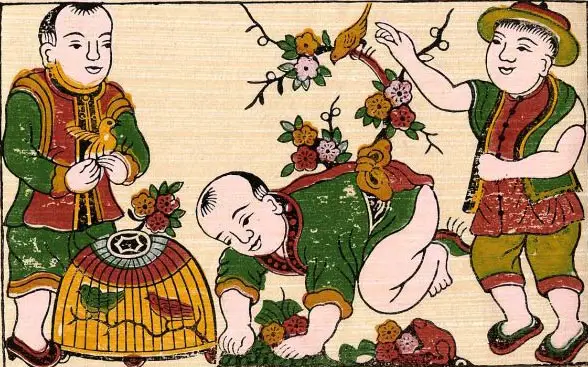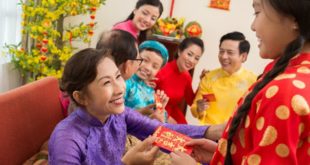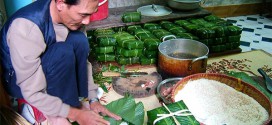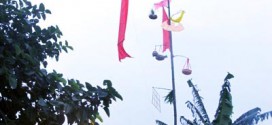You may have seen them before. They adorn the walls of Vietnamese restaurants everywhere in the world and Vietnamese overseas hang them up as Lunar New Year approaches. In Vietnam, the production of these folk paintings peaks right before Tet as merchants stock up in anticipation of heavy customer demand. These paintings are traditionally used to decorate homes for the New Year festival.
Producing Dong Ho paintings is a trade time-honored tradition of the village of Dong Ho. It is Dong Ho paintings that make Dong Ho village famous across Vietnam as well as in the world. In fact, only Dong Ho village’s people can turn out real Dong Ho paintings.

The village of Dong Ho is in Ha Bac, the province just north of Hanoi. Come there, besides impressive paintings, you can enjoy the beautiful rural scenery and fresh air of Vietnam’s countryside. However, whenever people mention to Dong Ho village, first of all, they remember Dong Ho paintings.
The production of Dong Ho paintings is rather sophisticated. It can be described as follows
The printmaking process
The prints are made by brushing paint made of local material onto carved wood blocks, then pressing the blocks on paper. The print is left to dry after each color is applied before another color is added. Three to five colors are used to make each print.
The wood blocks
The wooden blocks are made from the thi tree, a soft fibrous wood. The block is used as a printing plate, with one block for each color, print and size. A big shelf in the printing room holds hundreds of wood blocks. Among them, some are 200 years old. Wood block carving is an art handed down within the family by the master to his children. In the village, there are some families who have been making prints for many generations. Coming to visit Dong Ho village, you can see many sons and several daughters working, learning the craft from their fathers, and carrying on the family tradition.
The paper
The prints are all done on traditional giay gio paper made from the bark fiber of the do tree. This tree grows in the northwestern part of the country. The sheath is stripped off the tree trunk and soaked in a pond for a month. It is then dipped in limewater for two weeks, followed by a wash. After ten days or so the pulp is poured into frames which are stacked for several more days. Then the stacks are arranged on a wall to dry and pressed smooth with a stone mortar.
The paper is coated with a pulverized powder made from shellfish found in the Hai Phong area. The shellfish is brought to the village and coated with mud for two years. The entire mixture is then ground up by stone mortar and put into a water tank to be filtered and pressed into balls that weigh about a kilo and they are left to dry on the walls or floors. They are then used as needed and mixed with glue. This mixture is called diep powder.
The brush
The prints are painted with a beautiful brush made of spruce. The thet brushes are made from dried spruce leaves bound together. These brushes are made in a village not far away and come in various sizes. The leaves are pounded with salt water and a hammer to make the brush tip soft enough and are bound together and flattened at the top.
The paint
The folk art simplicity has strong and simple contours with bright colors that are made from dried bamboo leaves, the local fruits, flowers, and leaves. The paint is mixed in large earthenware pots. The colors are mixed by hand and each artisan has his or her own formula. The red paint is made from soi son, a soft stone that is found in the region. The blue paint is made from indigo leaves found in the minority areas. Both of these paints must be soaked in an earthenware pot for a couple of years and strained of all impurities.
Yellow paint usually comes from the sophora tree whose flowers are as small as rice kernels. The flowers are roasted in a pan until they turn brownish-yellow. When water is added and the mixture is boiled, a yellow color appears. The liquid is filtered and the pulp is thrown away. The violet color comes from the mong toi fruit. Black paint comes from the bamboo tree. When the bamboo trees shed their leaves, they are burned to a cinder, then sprinkled with water and put in a glazed clay jar half filled with water. After a year or more, the water is strained and the black ink is ready for use after being mixed with glutinous rice glue.
Grinding glutinous rice into a fine powder and mixing it with water makes the rice glue. As the rice powder settles to the bottom, the clear water is skimmed off every day, to prevent the contents from fermenting.
The stories Each print tells a story of historical significance. The prints are used to carry on the cultural history of Vietnam, passed on at the welcoming of each Lunar New Year to younger generations through storytelling. The themes of happiness, good luck, fertility, good fortune, and prosperity are common. They celebrate the optimism for the coming New Year.
Every year, when Tet comes closer the village’s people are busy producing Tet prints, transporting them to Hanoi for sale to wholesalers who distribute them all over the country, keeping the tradition alive. Dong Ho paintings are still something that can not lack in Vietnam’s Tet. And many foreigners like these paintings and often buy them as souvenirs for their
 Vietnamese Culture and Tradition
Vietnamese Culture and Tradition 


